Seacell sweaters offer exceptional moisture-wicking and skin-soothing properties due to their seaweed-infused fibers, while wool sweaters provide superior insulation and natural breathability for cold weather. Choosing between Seacell and wool depends on the priority of hypoallergenic comfort versus traditional warmth and durability.
Table of Comparison
| Feature | Seacell | Wool |
|---|---|---|
| Origin | Seaweed fibers blended with cellulose | Natural animal fiber from sheep |
| Softness | Very soft and smooth | Soft to coarse, varies by type |
| Breathability | High moisture-wicking ability | Excellent insulation and breathability |
| Hypoallergenic | Yes, gentle on sensitive skin | May cause allergies in some individuals |
| Eco-Friendliness | Biodegradable and sustainable | Natural and renewable but requires more resources |
| Durability | Moderate durability | Highly durable with proper care |
| Care Instructions | Gentle wash recommended | Often requires hand wash or dry cleaning |
| Thermal Regulation | Moderate warmth | Excellent thermal insulation |
Introduction to Seacell and Wool Sweaters
Seacell sweaters, made from innovative fibers infused with seaweed extract, offer natural breathability, moisture-wicking, and skin-soothing properties, making them ideal for sensitive or allergy-prone skin. Wool sweaters, crafted from animal fibers like merino or cashmere, provide exceptional warmth, durability, and moisture regulation, popular for cold-weather apparel. Choosing between Seacell and wool involves weighing eco-friendly, hypoallergenic benefits against traditional insulating qualities.
What is Seacell Fiber?
Seacell fiber is an innovative textile made from natural cellulose extracted from seaweed combined with wood pulp, offering eco-friendly and skin-friendly properties. This fiber provides excellent breathability, moisture-wicking, and antibacterial benefits, making it ideal for sensitive skin compared to traditional wool. Unlike wool, which is warm and insulating, Seacell enhances comfort by integrating marine nutrients that support skin health while maintaining softness and durability.
Wool: A Classic Sweater Material
Wool, a classic sweater material, offers excellent insulation and moisture-wicking properties, making it ideal for cold climates. Its natural elasticity and durability provide long-lasting comfort and shape retention. Unlike Seacell, wool is widely recognized for its breathability and ability to regulate body temperature effectively.
Sustainability and Environmental Impact
Seacell fibers, derived from sustainably harvested seaweed, offer biodegradable and renewable alternatives to traditional wool, reducing reliance on animal farming and its associated methane emissions and land use. Wool production involves higher water consumption and energy-intensive processes, whereas Seacell's eco-friendly cultivation supports marine ecosystems and decreases chemical treatments. Choosing Seacell sweaters promotes lower carbon footprints and aligns with eco-conscious fashion trends prioritizing sustainability and environmental preservation.
Comfort and Softness Comparison
Seacell fibers offer exceptional softness and moisture-wicking properties, creating a breathable sweater ideal for sensitive skin and prolonged wear. Wool provides natural insulation and warmth but can sometimes feel coarse or itchy, depending on the fiber type and processing. For ultimate comfort and softness, Seacell blends often surpass traditional wool by combining gentle texture with antimicrobial benefits.
Breathability and Moisture Management
Seacell fibers, derived from seaweed, provide superior moisture management by naturally absorbing and releasing moisture, keeping the skin dry and comfortable. Wool, especially merino wool, excels in breathability by allowing air circulation and effectively wicking sweat away from the body, preventing overheating. While both materials offer excellent moisture regulation, Seacell is particularly beneficial for those seeking enhanced moisture absorption with a silky texture, whereas wool provides robust temperature regulation and odor resistance.
Durability and Longevity
Seacell fibers offer excellent durability due to their natural cellulose and seaweed-infused composition, which enhances fabric strength and resistance to wear. Wool, particularly merino or cashmere, is renowned for its longevity, as its natural elasticity helps the sweater retain shape over time despite frequent use. Both materials provide durable options, but wool generally excels in maintaining structural integrity after repeated washes and extended wear.
Hypoallergenic Properties
Seacell fibers, derived from seaweed and cellulose, exhibit natural hypoallergenic properties by inhibiting bacterial growth and reducing skin irritation, making them suitable for sensitive skin. Wool, especially merino, provides excellent breathability and moisture-wicking but can sometimes cause allergic reactions or itchiness due to lanolin content and coarse fibers. For allergy-prone individuals, Seacell sweaters offer a gentler alternative with antimicrobial benefits, whereas hypoallergenic wool variants require careful selection to minimize irritation.
Style and Care Differences
Seacell sweaters offer a sleek, modern look with a smooth texture and subtle sheen, while wool sweaters provide a classic, textured appearance with natural bulk and warmth. Care for Seacell involves gentle hand washing or delicate machine cycles to maintain its softness and prevent fiber damage; wool requires careful hand washing or dry cleaning to avoid shrinking and maintain its insulating properties. Style versatility of Seacell suits lightweight, breathable designs perfect for layering, whereas wool excels in chunky knits ideal for colder climates and rustic aesthetics.
Which is Best: Seacell or Wool Sweaters?
Seacell sweaters offer superior moisture-wicking properties and natural antibacterial benefits, making them ideal for sensitive skin and active lifestyles, while wool sweaters excel in insulation and durability, providing unmatched warmth in colder climates. Seacell fibers, derived from seaweed and cellulose, add eco-friendly appeal and softness, contrasting with the traditional lanolin-rich wool which can sometimes cause irritation. Choosing between Seacell and wool depends on personal preferences for comfort, sustainability, and thermal needs in sweater wear.

Infographic: Seacell vs Wool for Sweater
 azmater.com
azmater.com